V-280 wins US ARMY FLRAA contract
Expected, but still disappointing.
Sikorsky and Boeing Challenge Army Decision to Replace Black Hawk with Bell V-280 Tiltrotor
https://www.defenseone.com/business/...trotor/381335/
https://www.defenseone.com/business/...trotor/381335/
Boeing Shows How the Defiant X Is Not That Different From the Black Hawk
It appears Boeing and Sikorsky have begun their media effort to overturn the Bell FLRAA contract award.
Lacking any valid Defiant X performance capabilities over the V-280 to extol, Boeing and Sikorsky are left with insinuating the V-280 is to big to be compatible with existing US Army infrastructure. But is the V-280 size even an issue?
Based on scaling the images in the Sikorsky/Boeing video, the Defiant X is larger than the UH-60 Blackhawk. Significantly larger.
Using the Blackhawk main rotor diameter of 53' 8"as a reference, the Defiant X main rotor is approximately 59' 9" in diameter.
Using again the Blackhawk main rotor diameter as a reference for scaling, the hangar door opening shown in the video is approximately 62' wide. For worst case rotor position this leaves less than 14" clearance to the door opening on either side when towing the Defiant X into the hangar.
Indexing the Defiant X main rotor to as shown in the video reduces the aircraft width to approximately 56' 6", increasing door clearance to 33" per side. This would seem to be adequate clearance, but raises the question of how would mechanics index those two huge main rotors prior to towing?
The Bell V-280 Valor may visually appear larger than the Defiant X, but based on published data the V-280 is significantly shorter in total length. With the V-280's two main rotors indexed to minimize width for towing into a hangar, the aircraft is approximately 59' 4" wide (again based on scaling published data). For a hangar with a 62' opening, this provides 16" clearance on either side when towing the V-280 into the hangar. Note: On the V-22, manually indexing the two main rotors common procedure, performed from the ground with the pylons at 90 deg using a lanyard looped around a blade, or by hand with the pylons rotated to 45 deg to facilitate reach. I assume a similar procedures can be used on the V-280.
The ease in being able to manually index the rotors on the V-280 could also facilitate parking the V-280 in hangers with door openings smaller than the Defiant X would fit. By manually reindexing the V-280 rotors after the first blade passes through the hangar door, the effective aircraft width would be approximately 51'.
As far as footprint on the ground, as noted the Defiant X is significantly larger than the UH-60 Blackhawk. Just look at the relative aircraft sizes in the Sikorsky/Boeing video. Therefore, with maintaining the same rotor to rotor clearances used on the Blackhawk footprint, this claim appears to be a stretch. Additionally, ground footprint comparisons of the Defiant X to the V-280 need to take into consideration the different proportions of each aircraft.
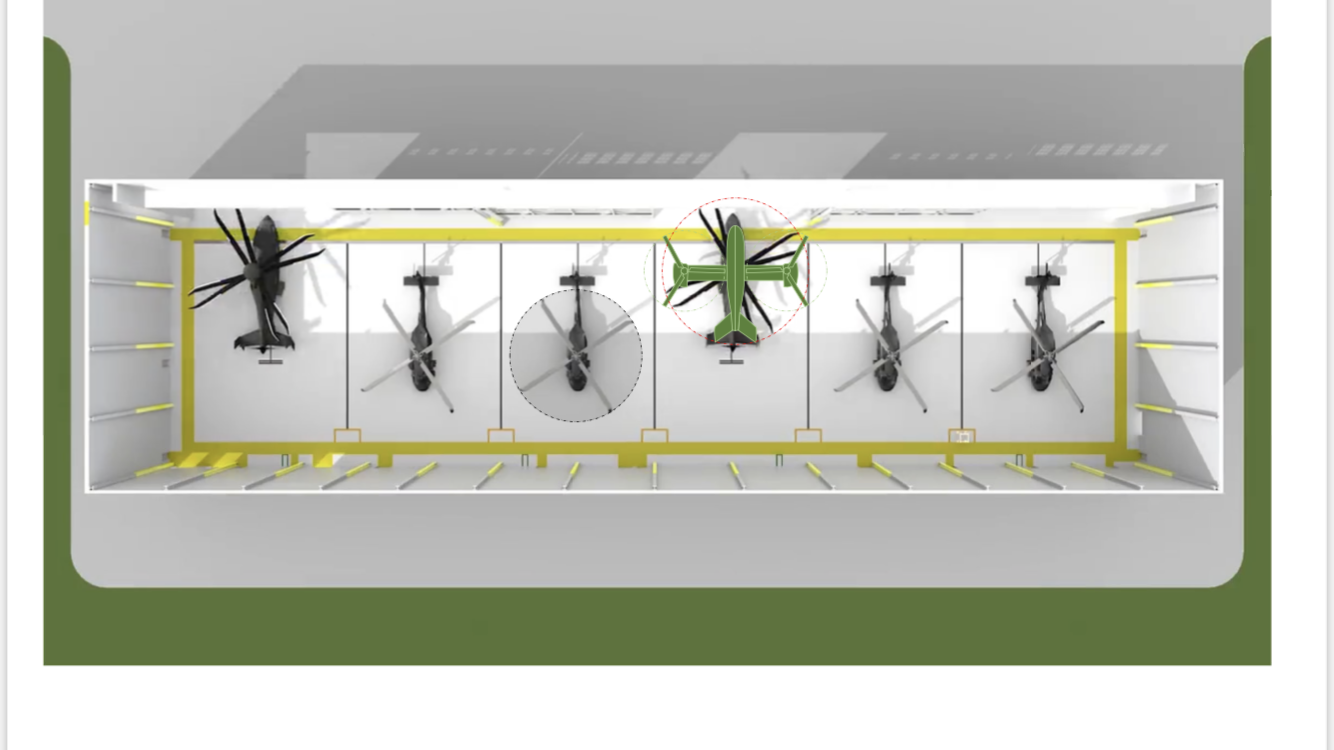
Lacking any valid Defiant X performance capabilities over the V-280 to extol, Boeing and Sikorsky are left with insinuating the V-280 is to big to be compatible with existing US Army infrastructure. But is the V-280 size even an issue?
Based on scaling the images in the Sikorsky/Boeing video, the Defiant X is larger than the UH-60 Blackhawk. Significantly larger.
Using the Blackhawk main rotor diameter of 53' 8"as a reference, the Defiant X main rotor is approximately 59' 9" in diameter.
Using again the Blackhawk main rotor diameter as a reference for scaling, the hangar door opening shown in the video is approximately 62' wide. For worst case rotor position this leaves less than 14" clearance to the door opening on either side when towing the Defiant X into the hangar.
Indexing the Defiant X main rotor to as shown in the video reduces the aircraft width to approximately 56' 6", increasing door clearance to 33" per side. This would seem to be adequate clearance, but raises the question of how would mechanics index those two huge main rotors prior to towing?
The Bell V-280 Valor may visually appear larger than the Defiant X, but based on published data the V-280 is significantly shorter in total length. With the V-280's two main rotors indexed to minimize width for towing into a hangar, the aircraft is approximately 59' 4" wide (again based on scaling published data). For a hangar with a 62' opening, this provides 16" clearance on either side when towing the V-280 into the hangar. Note: On the V-22, manually indexing the two main rotors common procedure, performed from the ground with the pylons at 90 deg using a lanyard looped around a blade, or by hand with the pylons rotated to 45 deg to facilitate reach. I assume a similar procedures can be used on the V-280.
The ease in being able to manually index the rotors on the V-280 could also facilitate parking the V-280 in hangers with door openings smaller than the Defiant X would fit. By manually reindexing the V-280 rotors after the first blade passes through the hangar door, the effective aircraft width would be approximately 51'.
As far as footprint on the ground, as noted the Defiant X is significantly larger than the UH-60 Blackhawk. Just look at the relative aircraft sizes in the Sikorsky/Boeing video. Therefore, with maintaining the same rotor to rotor clearances used on the Blackhawk footprint, this claim appears to be a stretch. Additionally, ground footprint comparisons of the Defiant X to the V-280 need to take into consideration the different proportions of each aircraft.

Last edited by CTR; 5th Jan 2023 at 14:19.
Isn’t the blade diameter more important re the landing zones any of these can get into?
Obviously getting them into a hangar is good , but I don’t think the people being shot at & waiting on the ground will care about that.
Again , I don’t see that other than speed & ‘Wow , it’s different’ , either proposal is bringing much to the party.
Obviously getting them into a hangar is good , but I don’t think the people being shot at & waiting on the ground will care about that.
Again , I don’t see that other than speed & ‘Wow , it’s different’ , either proposal is bringing much to the party.
Isnít the blade diameter more important re the landing zones any of these can get into?
Obviously getting them into a hangar is good , but I donít think the people being shot at & waiting on the ground will care about that.
Again , I donít see that other than speed & ĎWow , itís differentí , either proposal is bringing much to the party.
Obviously getting them into a hangar is good , but I donít think the people being shot at & waiting on the ground will care about that.
Again , I donít see that other than speed & ĎWow , itís differentí , either proposal is bringing much to the party.
Agreed. Check out the video below.
note that the V-280 not only provides 300 kits speed, but also twice the range and more payload than a Blackhawk.
Agreed. Check out the video below.
https://www.facebook.com/BellFlight/...1502048366351/
note that the V-280 not only provides 300 kits speed, but also twice the range and more payload than a Blackhawk.
https://www.facebook.com/BellFlight/...1502048366351/
note that the V-280 not only provides 300 kits speed, but also twice the range and more payload than a Blackhawk.
I remain cynical in many ways about the V-280 though!
The following users liked this post:
!
Indeed , thanks!
Everyone’s better than me at maths , could someone work out the cost per Kg etc load carried by each airframe?
I mean based on the cost of the aircraft v the payload?
I suspect that though the V-280 can lift more , it’ll cost more because it’s a daftly expensive piece of kit!
There have been lots of comments regarding it now being ‘A 300mph battlefield’ but if your allies & other arms only have the old & slow stuff , doesn’t the battlefield remain slow too?
Everyone’s better than me at maths , could someone work out the cost per Kg etc load carried by each airframe?
I mean based on the cost of the aircraft v the payload?
I suspect that though the V-280 can lift more , it’ll cost more because it’s a daftly expensive piece of kit!
There have been lots of comments regarding it now being ‘A 300mph battlefield’ but if your allies & other arms only have the old & slow stuff , doesn’t the battlefield remain slow too?
Last edited by Chock Puller; 5th Jan 2023 at 00:06. Reason: Stick to the topic.
!
I mean based on the cost of the aircraft v the payload?
I suspect that though the V-280 can lift more , itíll cost more because itís a daftly expensive piece of kit!
There have been lots of comments regarding it now being ĎA 300mph battlefieldí but if your allies & other arms only have the old & slow stuff , doesnít the battlefield remain slow too?
I mean based on the cost of the aircraft v the payload?
I suspect that though the V-280 can lift more , itíll cost more because itís a daftly expensive piece of kit!
There have been lots of comments regarding it now being ĎA 300mph battlefieldí but if your allies & other arms only have the old & slow stuff , doesnít the battlefield remain slow too?
Iím sure some will try to use V-22 data as a baseline for the V-280 Valor. That would be a flawed comparison, however. The V-22 was the first generation production, tiltrotor, and the V-280 incorporates the many lessons, learned from700,000 V-22 flight hours.
At the same time, others will try to claim that the Defiant is similar to the Blackhawk. That would be even a more flawed a comparison. The Defiant is a very much more complex machine compared to a Blackhawk. And the total number of flight hours to base any evaluation on, is limited to a few hundred accumulated on flight test aircraft.
Qualitatively, it may be possible to draw some conclusions based on the complexity of each design. Maybe others out there can provide the information you are requesting.
As far as the speed question, higher speed makes sure you get there before the other guy. Getting you back fast saves lives.
Join Date: Jul 2021
Location: Southern United States
Posts: 122
Likes: 0
Received 60 Likes
on
30 Posts
Regarding compatibility of either Defiant or V-280 with existing US Army facilities, taking a look at Unified Facilities Criteria UFC 3-260-01, both aircraft would require a similar parking pad layout along the lines of the current Navy/Marines V-22 Parking pad in dimensions as shown below:
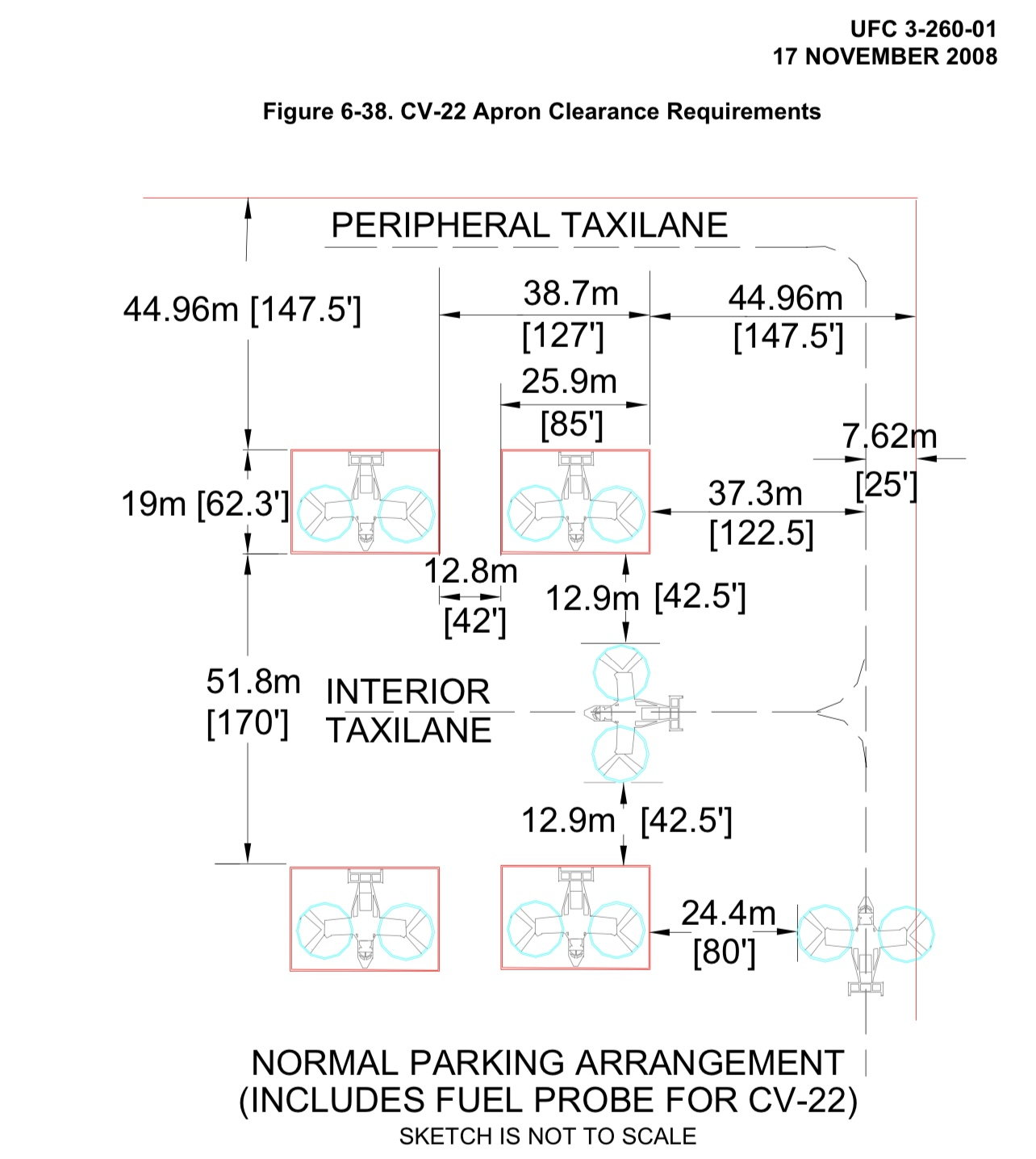
As far as Hangar Facilities go, hereís a table and figure out of UFC 4-211-01 that talks about clearances etc. I can tell you right now that my facility would only accommodate 2 V-280s per hangar and maybe 4 Defiant vs the 6 H-60ís we can currently accommodate:
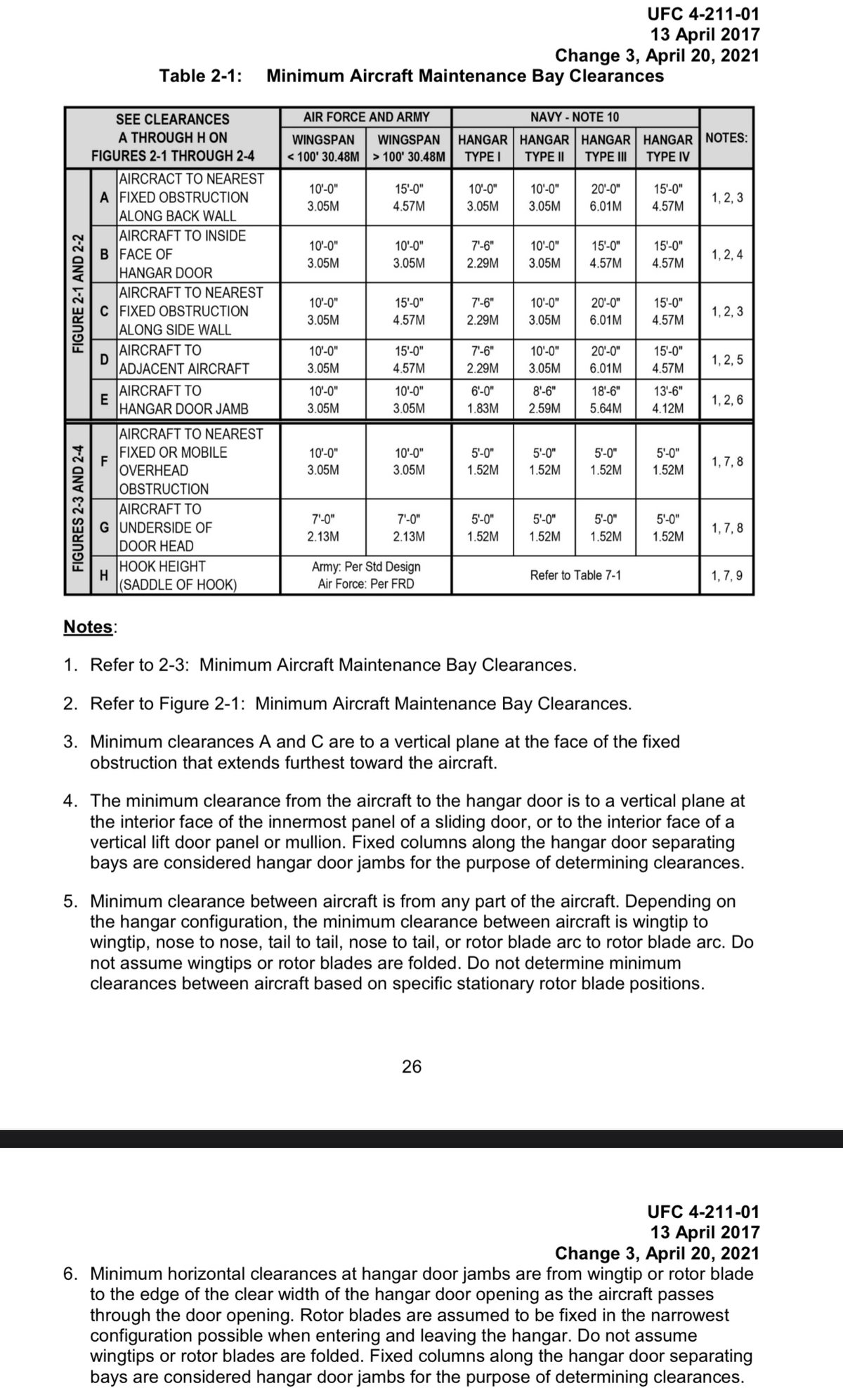
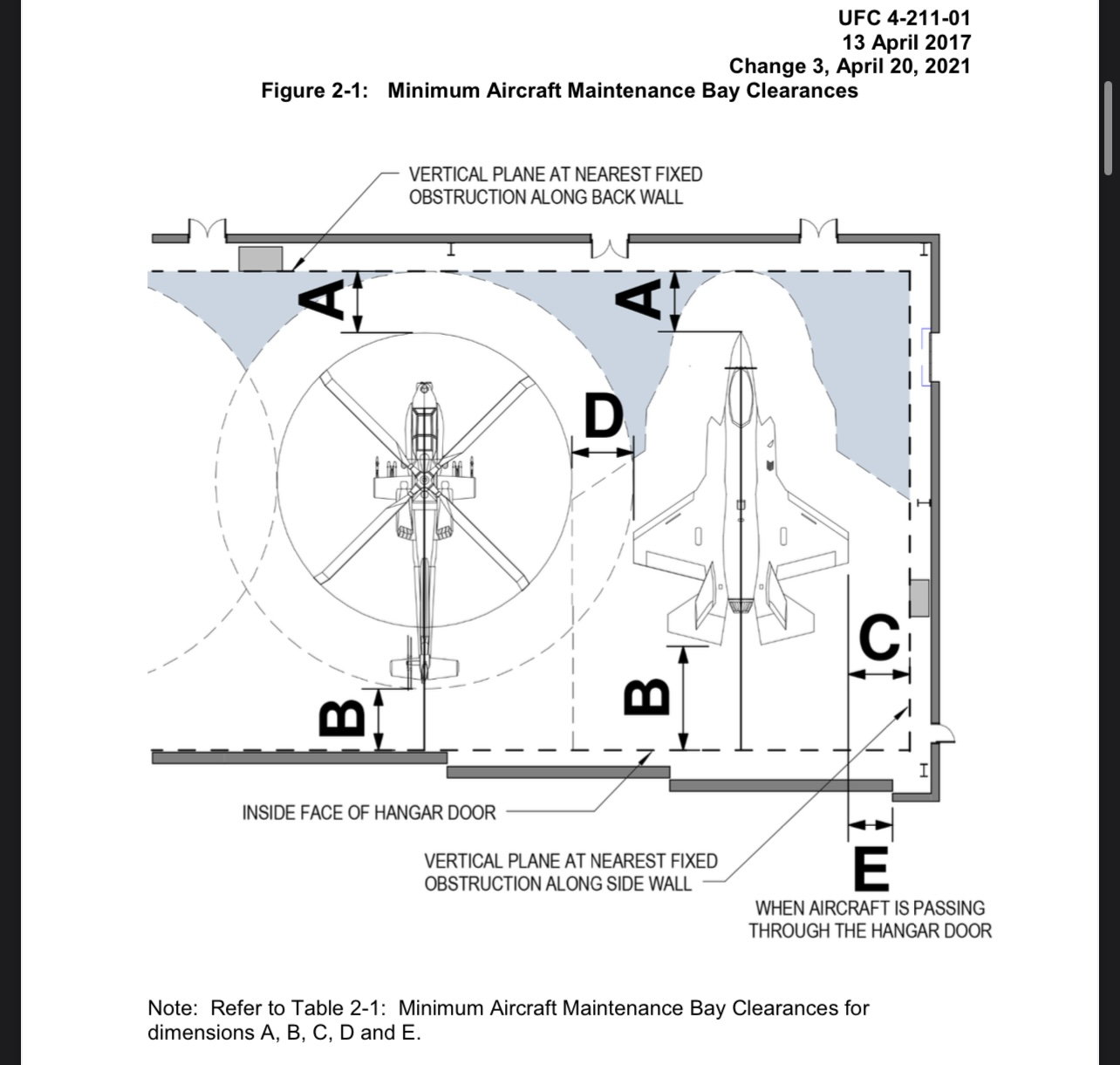
I looks like we would lose 2-3 parking pads per aircraft depending on which aircraft was selected.
FltMech

As far as Hangar Facilities go, hereís a table and figure out of UFC 4-211-01 that talks about clearances etc. I can tell you right now that my facility would only accommodate 2 V-280s per hangar and maybe 4 Defiant vs the 6 H-60ís we can currently accommodate:


I looks like we would lose 2-3 parking pads per aircraft depending on which aircraft was selected.
FltMech
Thank you for the data
FltMech,
Thanks for the data. I was especially interested in the requirement for minimum rotor to rotor spacing.
I just added to my earlier post an image superimposing the V-280 on top of the Defiant in a screen shot of the hangar used in the Boeing video.
Based on this image generated from available published data, how do you see the Defiant requiring less hangar space? Note that the blades on the Defiant do not fold, despite promotional videos you have seen. Sikorsky is still attempting to make the X-2 rigid rotor work without the complexity of folding
Thanks for the data. I was especially interested in the requirement for minimum rotor to rotor spacing.
I just added to my earlier post an image superimposing the V-280 on top of the Defiant in a screen shot of the hangar used in the Boeing video.
Based on this image generated from available published data, how do you see the Defiant requiring less hangar space? Note that the blades on the Defiant do not fold, despite promotional videos you have seen. Sikorsky is still attempting to make the X-2 rigid rotor work without the complexity of folding
Last edited by CTR; 5th Jan 2023 at 14:46.
Join Date: Jul 2021
Location: Southern United States
Posts: 122
Likes: 0
Received 60 Likes
on
30 Posts
Iím wondering if the dimensions we are seeing for either aircraft are accurate. In the case of Defiant Iím not sure Iíve even seen official dimensions published anywhere. I canít see how they fit in the same footprint as as an H-60 but your image makes a compelling argument against what Boeing/Sikorsky may be claiming.
Having said that, credit to the Army if they actually made the size requirement around a legacy aircraft and stuck to it, not an insignificant cost to revamp all Army Facilities!
flt mech
Having said that, credit to the Army if they actually made the size requirement around a legacy aircraft and stuck to it, not an insignificant cost to revamp all Army Facilities!
flt mech
It's unlikely this was a low bid (in governmentalese "Lowest Price Technically Acceptable") competition. Those are used when, "... requirements are well defined; risk of unsuccessful contract performance is minimal...". Causally this is an off the shelf item or something that is very similar to regular commercial items with no major development or unique requirements expected.
FLRAA isn't that kind of a program.
I have no idea what price either company proposed, but even if the SB>1 came in at a lower bid price,aside from the performance differences the Army would hove to look at what was accomplished by both competitors in the JMR-TD phase to give them a feel for how likely it was that the bidder could achieve what they promised. Clearly Bell had an advantage here, not only for Valor's performance and demonstrations, but also with a history of successful Tilt-Rotor types stretching back to the 1980s, giving more confidence they'd be able to do what they promised.. This would also be factored in the decision. This definitely wasn't just a price shootout. Now the SB>1 team could protest, but there's a risk.If there's a protest lodged, the Gov't is free to defend itself by releasing data that would normally not be disclosed, in order to justify its decision.
Back in the late 1970s, the Coast Guard put out an RFP fpr a "Short Range Recocery (SRR) Aircraft". The Competitors were Bell with its Model 222 and Aerospatiale with a modified version of their 365C. The 365C won and became the HH-65. Bell protested, and so the Gov't released details of the evaluations that normally they wouldn't in order to defend their choice. This revealed that the 365C was not just better, it was a lot better. Once this data became public, it unquestionably would affect sales. The [unverified} story goes that the Bell team, including Marketing, didn't have the nerve to go into the lion's den of top management and tell them,"Our helicopter wasn't nearly as good" and so didn't object to the protest so that it would be the Gov't who would break the bad news. Now that story may be anecdotal, but I could see Sikorsky (and to a lesser extent Boeing) not going forward with a protest for similar reasons. They want to continue with X2 technology and there [i]may be stuff they just don't want to go public...
FLRAA isn't that kind of a program.
I have no idea what price either company proposed, but even if the SB>1 came in at a lower bid price,aside from the performance differences the Army would hove to look at what was accomplished by both competitors in the JMR-TD phase to give them a feel for how likely it was that the bidder could achieve what they promised. Clearly Bell had an advantage here, not only for Valor's performance and demonstrations, but also with a history of successful Tilt-Rotor types stretching back to the 1980s, giving more confidence they'd be able to do what they promised.. This would also be factored in the decision. This definitely wasn't just a price shootout. Now the SB>1 team could protest, but there's a risk.If there's a protest lodged, the Gov't is free to defend itself by releasing data that would normally not be disclosed, in order to justify its decision.
Back in the late 1970s, the Coast Guard put out an RFP fpr a "Short Range Recocery (SRR) Aircraft". The Competitors were Bell with its Model 222 and Aerospatiale with a modified version of their 365C. The 365C won and became the HH-65. Bell protested, and so the Gov't released details of the evaluations that normally they wouldn't in order to defend their choice. This revealed that the 365C was not just better, it was a lot better. Once this data became public, it unquestionably would affect sales. The [unverified} story goes that the Bell team, including Marketing, didn't have the nerve to go into the lion's den of top management and tell them,"Our helicopter wasn't nearly as good" and so didn't object to the protest so that it would be the Gov't who would break the bad news. Now that story may be anecdotal, but I could see Sikorsky (and to a lesser extent Boeing) not going forward with a protest for similar reasons. They want to continue with X2 technology and there [i]may be stuff they just don't want to go public...
in my copy of Athur Pearcys book, the Bell 222 proposed for the USCG role looks suspiciously like it had a S-76A tailboom put on it,
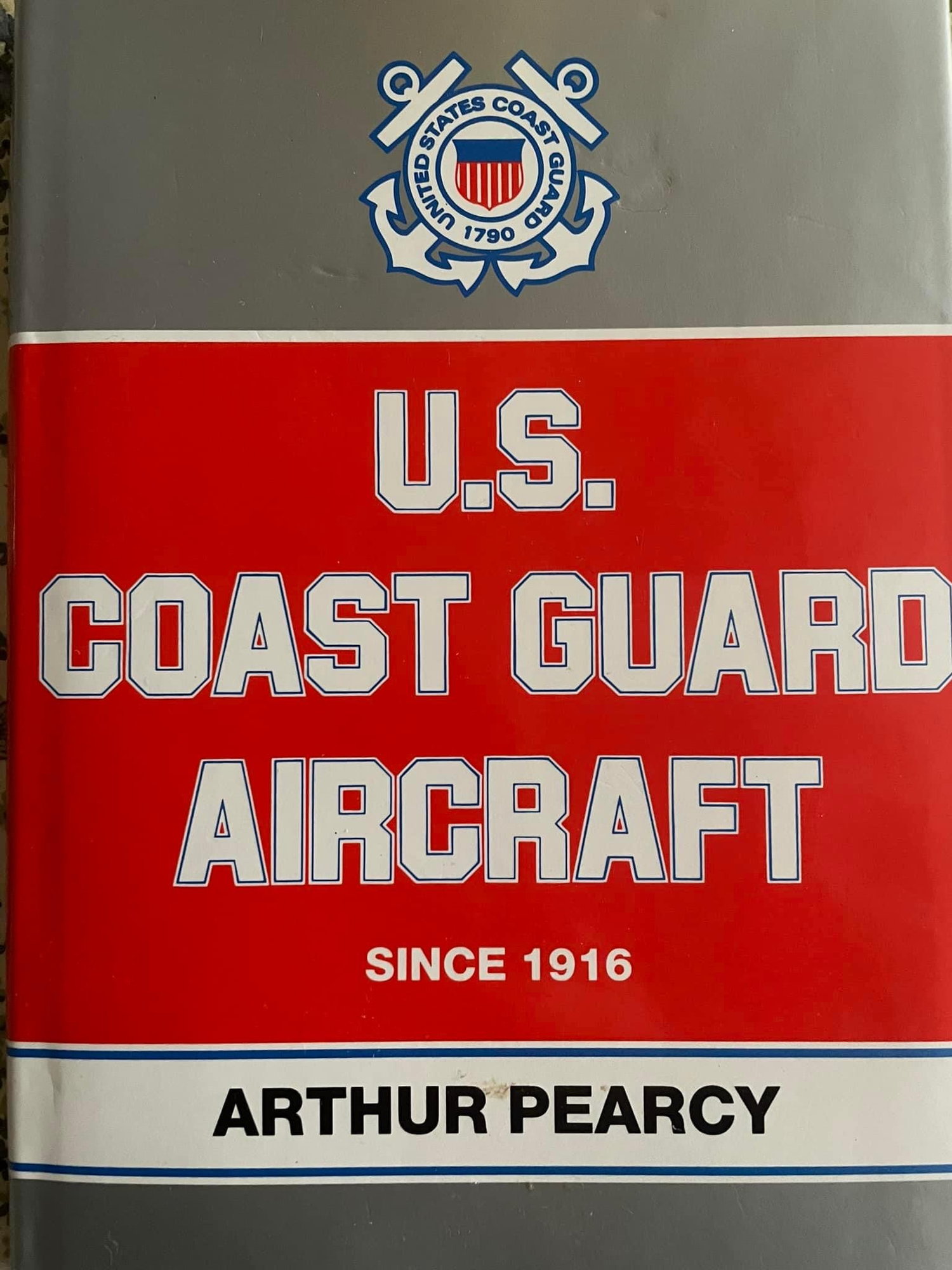
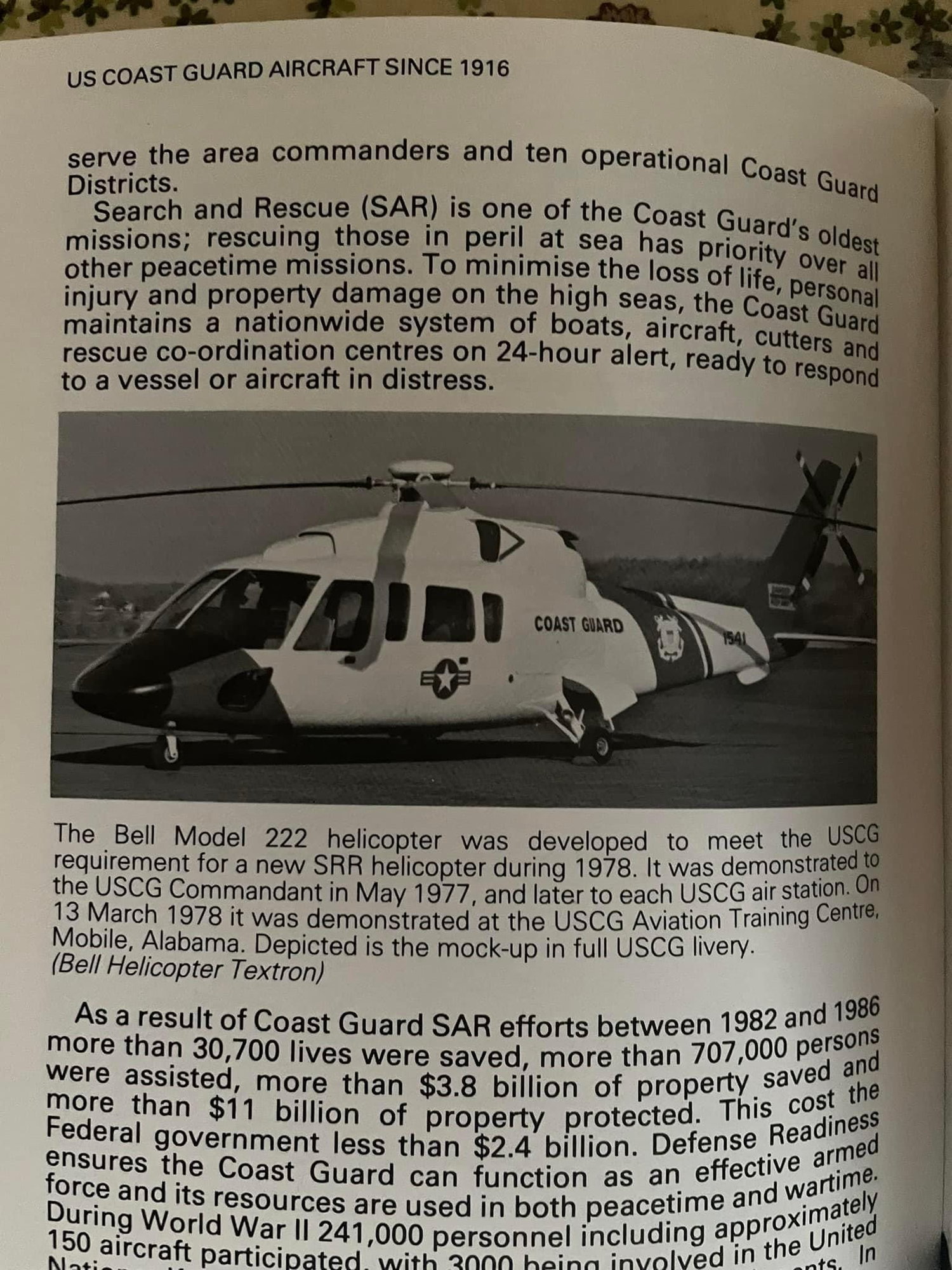
Sikorsky also offered their 76..

cheers
Sikorsky and Boeing Challenge Army Decision to Replace Black Hawk with Bell V-280 Tiltrotor
https://www.defenseone.com/business/...trotor/381335/
https://www.defenseone.com/business/...trotor/381335/
(As to the 'old and slow' problem the Marines got to enjoy the fun of their V-22s (potentially) outrunning their armed escorts, the AH-1W, which used to escort the Phrogs.
 Didn't stop them from getting V-22s)
Didn't stop them from getting V-22s)An aircraft should be delivered for initial testing in 2024-ish, if the second-hand info I have is reliable.
The Valor you saw flying was the tech demonstrator. The first flight test article will have folded in some changes (lessons learned being applied, etc) before Prototype 1 rolls onto a flight line anywhere.
I’m wondering if the dimensions we are seeing for either aircraft are accurate.
In the case of Defiant I’m not sure I’ve even seen official dimensions published anywhere.
I can’t see how they fit in the same footprint as as an H-60 but your image makes a compelling argument against what Boeing/Sikorsky may be claiming.
Having said that, credit to the Army if they actually made the size requirement around a legacy aircraft and stuck to it, not an insignificant cost to revamp all Army Facilities!
flt mech
In the case of Defiant I’m not sure I’ve even seen official dimensions published anywhere.
I can’t see how they fit in the same footprint as as an H-60 but your image makes a compelling argument against what Boeing/Sikorsky may be claiming.
Having said that, credit to the Army if they actually made the size requirement around a legacy aircraft and stuck to it, not an insignificant cost to revamp all Army Facilities!
flt mech
Important questions to ask and answer.
(A number of folks have, above, addressed the "how to you get it across the ocean" question so I'll not belabor that point)
As to the dimensions: as both were demonstrators, I suspect the dimensions will get refined by the time Number 1 shows up, but the general magnitudes are probably close enough.
(IIRC, Mr Dixson can talk to the UH-60 shaft extension and air transport geometry for the Blackhawk...from that program's early days)
What shall the protest be based upon?
Has Sikorsky provided test results that fairly demonstrate an advantage over the Bell offering?
If so....what are they?
If the basic goal is to replace a portion of the BlackHawk fleet, Blackhawks costing on the order of Twenty Million Dollars each these days......at what per Unit Cost?
If the cabin space and lift capacity is the same as for the Blackhawk....do the pro's outweigh the con's when costs. are factored in and shall budgets allow for the planned fleet sizes?
Have both aircraft conducted sling load testing to prove that capability and what effect does underslung loads have on airspeed capability?
What are the actual empty weights compared to design empty weights and as we all know.....every aircraft gets heavier over time as new requirements and equipment get added.
Does th 280 have the same autorotation issues as does the V-22?
Any autorotation issues with the Sikorsky concept?
The Army should be very careful in its analysis of the two very different concepts along with ensuring the planned strategy fits with the reality of warfare in wake of revelations from the Ukraine War.
Has Sikorsky provided test results that fairly demonstrate an advantage over the Bell offering?
If so....what are they?
If the basic goal is to replace a portion of the BlackHawk fleet, Blackhawks costing on the order of Twenty Million Dollars each these days......at what per Unit Cost?
If the cabin space and lift capacity is the same as for the Blackhawk....do the pro's outweigh the con's when costs. are factored in and shall budgets allow for the planned fleet sizes?
Have both aircraft conducted sling load testing to prove that capability and what effect does underslung loads have on airspeed capability?
What are the actual empty weights compared to design empty weights and as we all know.....every aircraft gets heavier over time as new requirements and equipment get added.
Does th 280 have the same autorotation issues as does the V-22?
Any autorotation issues with the Sikorsky concept?
The Army should be very careful in its analysis of the two very different concepts along with ensuring the planned strategy fits with the reality of warfare in wake of revelations from the Ukraine War.
The following users liked this post:
While reading about the engineering challenges and additional height associated with the Defiant X double rotor, I wondered to myself why they didn't go for a conventional main rotor and articulate the tail rotor (a bit like the Valor but horizontally) so that it could be configured like a standard heli at low speed but as a pusher at high speed. It would probably also require either one or two winglets to counter the effect of retreating blade stall at high forward airspeed. Just when I though to myself "Eureka", I of course found that something similar has been tried already.
https://en.wikipedia.org/wiki/Piasecki_X-49_SpeedHawk

https://en.wikipedia.org/wiki/Piasecki_X-49_SpeedHawk

Then there was this lovely Attack Helicopter that was way ahead of its time.
https://en.wikipedia.org/wiki/Lockheed_AH-56_Cheyenne
One thing that stands out to me is the empty weight of the various candidates and how that has grown over time and technology.
https://en.wikipedia.org/wiki/Lockheed_AH-56_Cheyenne
One thing that stands out to me is the empty weight of the various candidates and how that has grown over time and technology.
Another interesting bird! I see that it has 2 rotors on the tail rather than the ducted system on the speedhawk.
Does anyone know of a compound helicopter where the tail rotor itself articulates?
Does anyone know of a compound helicopter where the tail rotor itself articulates?




